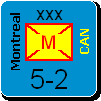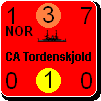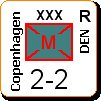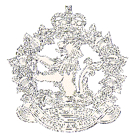Mike Dubost
Posts: 273
Joined: 8/24/2008
From: Sacramento, CA
Status: offline

|
quote:
ORIGINAL: mlees
quote:
ORIGINAL: Mike Dubost
You know, I was sure that the fate of the Oklahoma was wrong, since I knew she broke up while being towed to the West Coast. I looked around for a website reference to show it, and found that she was sold for scrap prior to the tow. One of my great aunts was talking a few years ago about her experiences in Hawaii during the war (she sailed to Hawaii in mid-December 1941), and she mentioned the Oklahoma. Her brother got her a job as his secretary (his company worked in the shipyard), and she mentioned the Oklahoma breaking up and she still sounded regretful about the wasted effort of raising the ship, even 60 years later!
You remembered correctly, Oklahoma foundered while under tow to the US west coast:
Wiki
quote:
Salvage
The difficult salvage job was commenced on 15 July 1942 by Pearl Harbor Naval Shipyard men under the immediate command of Captain F.H. Whitaker, USN. Preparations for righting the overturned hull took 7¾ months. The actual righting took 3¼ months, between 8 March 1943 and 16 June, with Oklahoma being towed into dry dock on 28 December. Decommissioned 1 September 1944, Oklahoma was stripped of guns and superstructure, and sold on 5 December 1946 to Moore Drydock Company of Oakland, California. Oklahoma sank on 17 May 1947, 540 miles out of Pearl Harbor, while being towed to San Francisco.
Of the battleships attacked at Pearl, here are their fates:
USS Nevada Managed to get underway during the attack, but attacked heavily while still in harbor. Ship beached on Hospital Point to avoid blocking channel. Repaired, and returned to service in time to participate in Aleutians in May '43. Other notable battles: Normandy/DDay, Southern France landings, Iwo Jima, Okinawa, bombardment of Japanese Home Islands. Used as target in Bikini Abomb tests, 1946. Radioactive hull sunk by conventional weapons, 65 miles SW of Pearl Harbor, 1948.
USS Arizona: Struck by converted battleship shell dropped as a bomb, detonating one of the magazines. Sank at moorings. Some wreckage cleared away, some guns used as coast defence guns on Oahu. Remains as a memorial.
USS West Virginia: Moored outboard of Tennessee on Dec 7. Hit by two converted battleship shell-bombs, and as many as seven torpedoes. Settled upright due to counter flooding. Refloated in May of '42, returned to service September of '44. Participated in Leyte Gulf battle, bombardments in the Phillippines, Iwo Jima, Okinawa. Ship decomissioned in January of '47, sold for scrap in Auguast, '59.
USS Tennessee: Moored inboard of West Virginia, Dec 7. Hit by two bombs. Ship repaired and returned to service in Febuary of '42. Remained in Eastern Pacific to guard US West Coast, with escort duties as far as Hawaii. Modernisation Aug '42 to May '43. Served in Aleutians, Tarawa, Marshall Islands, Solomons, Marianas, Peleliu, Leyte Gulf, Iwo Jima, and Okinawa battles. Decommisioned in Feb '47, sold for scrap in July of '59.
USS Maryland: Moored inboard of Oklahoma, struck by two bombs. Repaired and returned to service in Febuary of '42. Participated in Gilberts, Marshalls, Admiralty Islands, Marianas, Leyte Gulf, Okinawa battles. Decommisioned in April of '47, sold for scrap in July of '59.
USS Oklahoma: Moored outboard of Maryland. Struck by five torpedoes, capsized. Turned back upright in a three month operation that ended in June '43, decommisioned in September of '44. Sold for scrap, December of '46, sank under tow.
USS California: Struck by two torpedoes and two bombs. Slowly settled upright. Repaired and returned to service by May of '44. Participated in Marianas, Leyte Gulf, Okinawa battles. Decommisioned in Febuary of '47, sold for scrap July of '59.
USS Pennsylvania In dry dock on Dec 7, along with two destroyers. Struck by one bomb, but suffered damage from numerous near misses and explosions from the destroyers in the dock with her. Repaired and returned to service in April of '42. Participated in Aleutians, Gilberts, Marshalls, Florida Islands, Marianas, Peleliu, Leyte Gulf, Okinawa battles. Used as target in Bikini Abomb tests. Decomissioned in Aug of '46, radioactive hull sunk off Kwajalein in Feb '48.
Honorable mention: USS Utah Former BB-31, converted into radio controlled target in 1932, with main guns removed. In 1937, quad 1.1inch AA-machine guns were installed, and Utah served as an advanced AA gunnery school. Moored west of Ford Island on Dec 7. Struck by a torpedo, Utah slowly capsized. Decommisioned in Sep of '44, wreck remains in place.
Counting every ship that touched bottom, 5 active BB's sunk. Only Arizona, Oklahoma (and Utah) not returned to service.
Actually, I was wrong about the timing of the decommissioning versus the tow. I had thought she was still in commission at the time of the tow.
|
 Printable Version
Printable Version





















 New Messages
New Messages No New Messages
No New Messages Hot Topic w/ New Messages
Hot Topic w/ New Messages Hot Topic w/o New Messages
Hot Topic w/o New Messages Locked w/ New Messages
Locked w/ New Messages Locked w/o New Messages
Locked w/o New Messages Post New Thread
Post New Thread